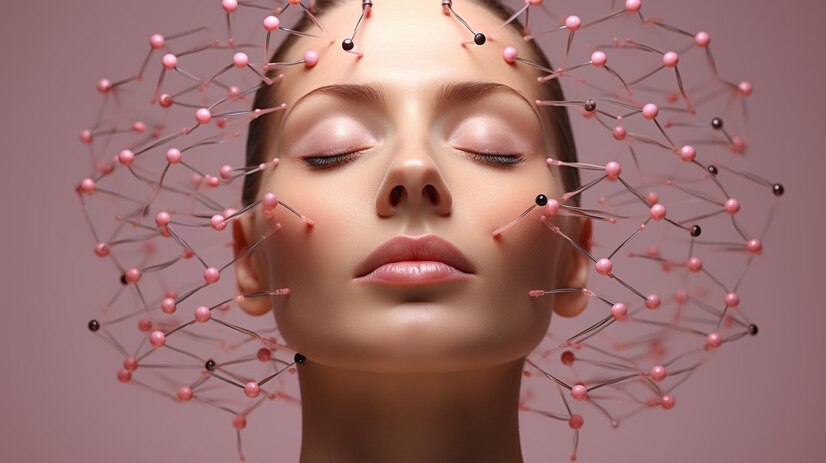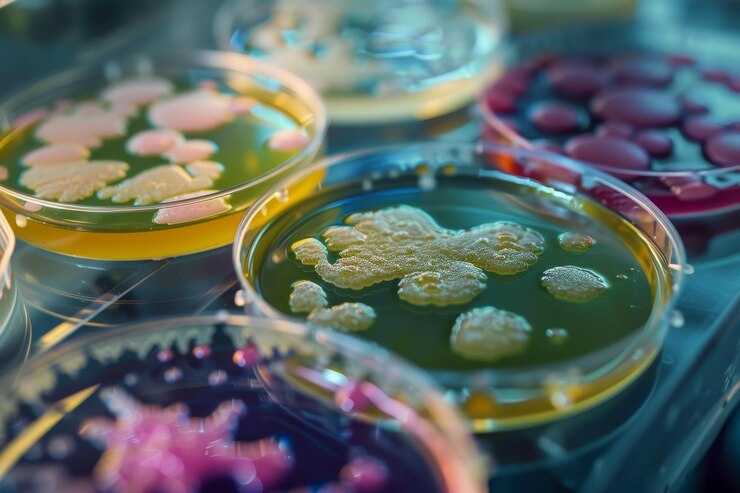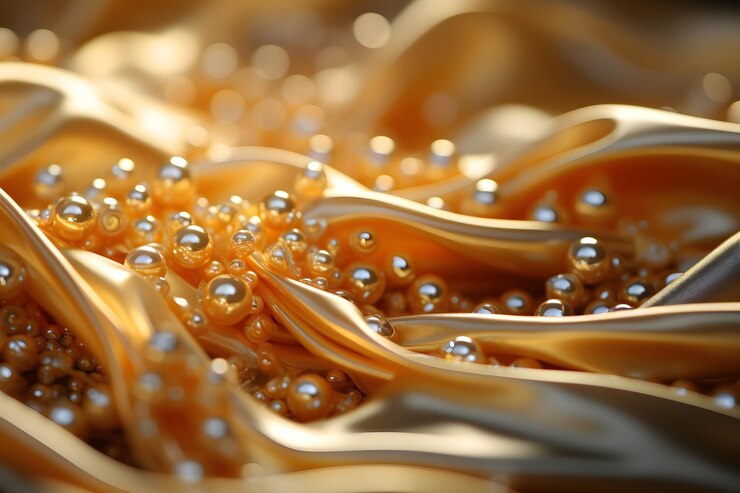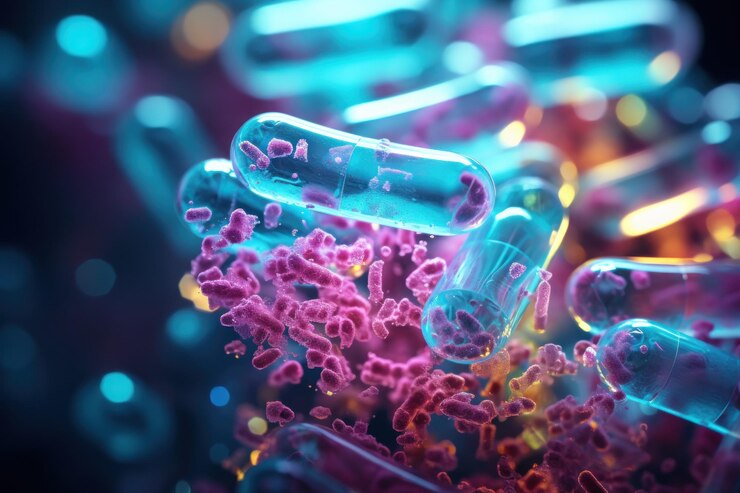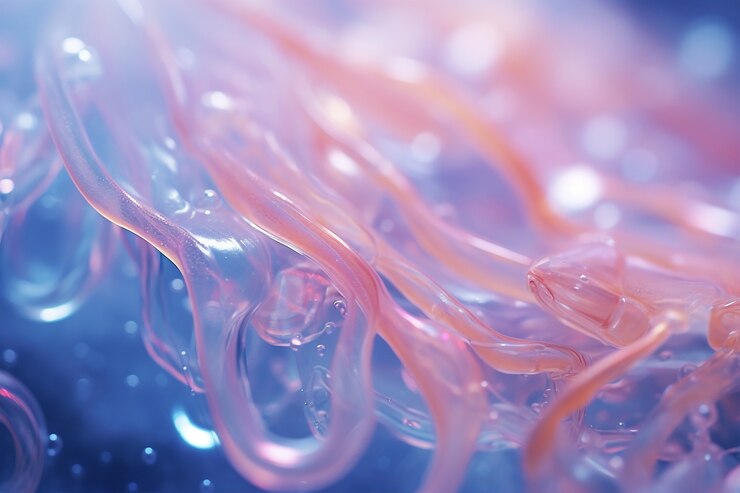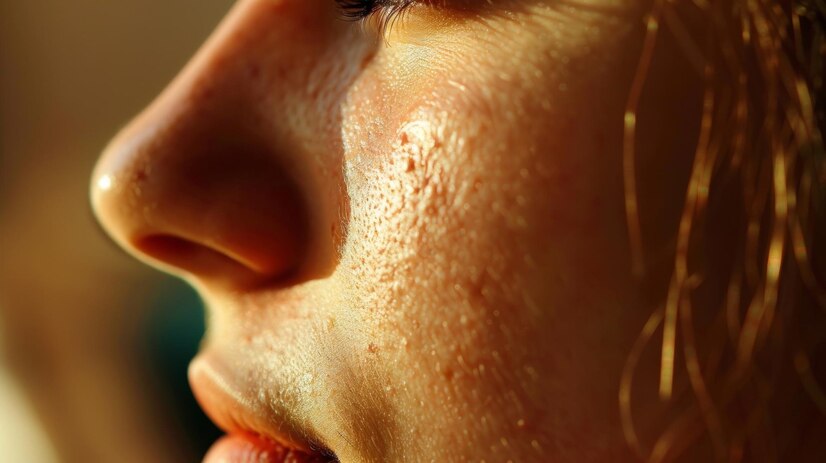Reshma Sultana and colleagues (2013) described strain-dependent augmentation of tight-junction barrier function in human primary epidermal keratinocytes by lactobacillus and Bifidobacterium lysates. Probiotic lysates, specifically from B. longum, can enhance tight junction function in human primary keratinocytes through signaling via Toll Like Receptor-2 (TLR2). The potential of bacterially derived components to improve tight junction function in keratinocytes is demonstrated, with ramifications for conditions like atopic dermatitis. Tight junctions are crucial for skin barrier function, and probiotic lysates may play a role in treating barrier dysfunction. The use of lysates from probiotic bacteria is preferred for skin health due to their safety record.
SUMMARY
the study investigated whether probiotic lysates can modify the tight-junction function of human primary keratinocytes
- The mechanism by which B. longum increases tight junctions (TJs) protein expression and transepithelial electrical resistance (TEER) is almost certainly associated with signaling through Toll Like Receptor-2 (TLR2)
- The peptidoglycan-induced increase in TJ function was Toll-like receptors (TLRs) dependent. All these data demonstrate the potential for bacterial lysate to augment TJ function in keratinocytes.
- It may be that some of the molecular mechanisms used by probiotic bacteria such as L. rhamnosus GG to increase TJ function are similar between gut and skin.
- Currently, virtually nothing is known regarding how TJs are formed or regulated in skin, so much more work is required in the area before firm conclusions can be reached as to how the L. rhamnosus GG lysate enhances keratinocyte TJ barrier function
- Lysates of probiotic bacteria could potentially play a role in the treatment of barrier dysfunction under conditions where the TJs are known to be aberrant, such as atopic dermatitis, where loss of expression of claudin 1 is reportedly involved in a subset of patients.
ABSTRACT
In this study, the authors investigated whether probiotic lysates can modify the tight-junction function of human primary keratinocytes. The keratinocytes were grown on cell culture inserts and treated with lysates from Bifidobacterium longum, Lactobacillus plantarum, Lactobacillus reuteri, Lactobacillus fermentum, or Lactobacillus rhamnosus GG. With the exception of L. fermentum (which decreased cell viability), all strains markedly enhanced tight-junction barrier function within 24 h, as assessed by measurements of transepithelial electrical resistance (TEER). However, B. longum and L. rhamnosus GG were the most efficacious, producing dose-dependent increases in resistance that were maintained for 4 days. These increases in TEER correlated with elevated expression of tight-junction protein components. Neutralization of Toll-like receptor 2 abolished both the increase in TEER and expression of tight-junction proteins induced by B. longum, but not L. rhamnosus GG. These data suggest that some bacterial strains increase tight-junction function via modulation of protein components but the different pathways involved may vary depending on the bacterial strain.
RESULTS
- Five strains of bacteria were evaluated for their effect on TJ function. Of these, lysates of all but L. fermentum were able to increase the TEER of keratinocytes. L. The other four strains of lactobacilli all enhanced TJ function, but to different degrees. In this regard, L. rhamnosus GG and B. longum produced greater and more sustained increases in TEER than did L. plantarum or L. reuteri.
- Peptidoglycan also induced increased transepithelial electrical resistance (TEER) in keratinocytes. However, the changes observed were strikingly different from those seen with whole lysates. Nevertheless, this raises the interesting possibility that cell wall components in the lysates may be at least partially responsible for the changes observed in TJ function. However, the significant differences between the effects of peptidoglycan and lysates, and the differential effects of lysates derived from specific strains, suggest that molecules specific to individual bacteria have different efficacies in enhancing barrier function.
- Both L. rhamnosus GG and B. longum increased the expression of TJ proteins in keratinocytes. However, the particular subset of molecules was different in each case.
- The modulation of protein expression by B. longum and L. rhamnosus GG is almost certainly the mechanism by which lysates of increase the TJ barrier function of keratinocytes. Changes in the expression levels of claudins in particular have been shown many times previously to be linked to changes in barrier function. Furthermore, the human skin disease atopic dermatitis, where the barrier is aberrant, is known to be associated with reduced claudin 1 expression. Hence, the evidence in skin so far suggests that expression of TJ proteins is associated with barrier function.
CONCLUSION
Lysates of probiotic bacteria could potentially play a role in the treatment of barrier dysfunction under conditions where the TJs are known to be aberrant, such as atopic dermatitis, where loss of expression of claudin 1 is reportedly involved in a subset of patients.
REFERENCES
Probiotic lysates can induce beneficial effects in maintaining natural microbiome balance
Topical application of certain probiotic bacteria, such as Lactobacillus reuteri and Lactobacillus rhamnosus, can protect skin cells from Staphylococcus aureus infection by preventing the bacteria from adhering to the cells, potentially aiding in the prevention of skin infections.
A research group led by Tessa Prince of the University of Manchester (2012) reported that recent studies have shown that probiotic bacteria, specifically L. reuteri, can protect human skin cells from the harmful effects of the pathogen S. aureus. The protective mechanism involves competitive exclusion of the pathogen from binding sites on the cells. This suggests that topical application of probiotics could prevent skin infections.
SUMMARY
- When normal primary human epidermal keratinocytes (NHEK) were exposed to a pathogen and L. reuteri, the probiotic protected the cells from the effects of the pathogen, as indicated by the significantly higher percentage of viability of S. aureus-infected NHEK in the presence versus absence of L. reuteri (Fig. 1a; see Fig. S2 in the supplemental material)
- The protective effects of the probiotic were variable between different species because the protection afforded by L. reuteri was greater than that provided by L. rhamnosus
- L. reuteri can protect keratinocytes from the pathogenic effects of S. aureus through exclusion and competition for binding sites
ABSTRACT
Recent studies have suggested that the topical application of probiotic bacteria can improve skin health or combat disease. We have utilized a primary human keratinocyte culture model to investigate whether probiotic bacteria can inhibit Staphylococcus aureus infection. Evaluation of the candidate probiotics Lactobacillus reuteri ATCC 55730, Lactobacillus rhamnosus AC413, and Lactobacillus salivarius UCC118 demonstrated that both L. reuteri and L. rhamnosus, but not L. salivarius, reduced S. aureus-induced keratinocyte cell death in both undifferentiated and differentiated keratinocytes. Keratinocyte survival was significantly higher if the probiotic was applied prior to (P < 0.01) or simultaneously with (P < 0.01) infection with S. aureus but not when added after infection had commenced (P > 0.05). The protective effect of L. reuteri was not dependent on the elaboration of inhibitory substances such as lactic acid. L. reuteri inhibited adherence of S. aureus to keratinocytes by competitive exclusion (P = 0.026). L. salivarius UCC118, however, did not inhibit S. aureus from adhering to keratinocytes (P > 0.05) and did not protect keratinocyte viability. S. aureus utilizes the α5β1 integrin to adhere to keratinocytes, and blocking of this integrin resulted in a protective effect similar to that observed with probiotics (P = 0.03). This suggests that the protective mechanism for L. reuteri-mediated protection of keratinocytes was by competitive exclusion of the pathogen from its binding sites on the cells. Our results suggest that use of a topical probiotic prophylactically could inhibit the colonization of skin by S. aureus and thus aid in the prevention of infection.
RESULTS
- The application of S. aureus at physiologically relevant concentrations killed 69.5% of NHEK within 24 h. In contrast, none of the strains of lactobacilli significantly affected the viability of NHEK under the same conditions, suggesting that probiotics were well tolerated by keratinocytes.
- When NHEK were exposed to both pathogen and L. reuteri, the probiotic protected the cells from the effects of the pathogen, as indicated by the significantly higher percentage of viability of S. aureus-infected NHEK in the presence versus absence of L. reuteri.
- The protective effect of L. reuteri against S. aureus-induced cell death of keratinocytes could result from several different mechanisms. One of the mechanisms by which L. reuteri protects keratinocytes appears to be linked to the ability of L. reuteri to prevent adhesion of S. aureus
CONCLUSION
This article has investigated the ability of three strains of lactobacilli to protect keratinocytes from the effects of the common skin pathogen S. aureus. Probiotic lysate can protect skin cells from Staphylococcus aureus infection by preventing the bacteria from adhering to the cells, potentially aiding in the prevention of skin infections.
REFERENCES
Anti-acne effect of Lactobacillus plantarum lysate
A team at the Cell Therapy Research Institute led by Christine Podrini (2023) report that Acne is a common inflammatory skin condition, and the Lactiplantibacillus plantarum serum has shown enhanced viability of L. plantarum bacteria, potentially offering a new approach to acne management. The serum did not exhibit toxic responses on the skin and resulted in improved viability in subjects. Acne is a complex disease that can impact quality of life and lead to scarring. Lactiplantibacillus plantarum aims to prevent the production of inflammatory mediators and inhibit acne-causing bacteria, offering a potential solution for acne management.
SUMMARY
- Acne remains the most common inflammatory dermatosis treated worldwide
- The impact of the combined components found in the SkinDuoTM serum that included mannitol, hyaluronic acid and vitamin B1 on L. plantarum viability was assessed by comparing it to the viability of the L. plantarum solemnly
- The proportion of alive bacteria was overall stable over time, an increased number of L. plantarum was observed after 7 days and 4 weeks for the SkinDuoTM dry formulation when compared to L. plantarum only (Figure S1), suggesting an enhanced viability
- The results of this study have demonstrated the potential of SkinDuoTM as a new approach to acne management
- The generation of an inflammatory process plays a key role in the pathophysiology of acne, and SkinDuoTM is designed to prevent the production of inflammatory mediators
- Resulting 9/10 subjects that applied the serum SkinDuoTM resulted in more than 50% mean viability when compared to initial time 0
- Serum did not exhibit toxic responses on the skin, and the topical formulation is suitable for the application of live bacteria in a sufficient dose on the skin that is delivered in a viable state
ABSTRACT
The tailoring of the skin microbiome is challenging and is a research hotspot in the pathogenesis of immune-mediated inflammatory skin diseases such as acne. Commonly encountered preservatives used as functional ingredients have an impact on the skin microbiota and are known to inhibit the survival of skin commensal bacteria. The selected species is Lactiplantibacillus plantarum. Ex vivo human skin models were used as a test system to assess the strain viability which was then validated on healthy volunteers. Lactiplantibacillus plantarum showed increased viability over time for in vitro skin models and a stable viability of over 50% on healthy skin. The strain was tested on human primary sebocytes obtained from sebaceous gland rich areas of facial skin and inoculated with the most abundant bacteria from the skin microbiota. Results on human ex vivo sebaceous gland models with the virulent phylotype of Cutibacterium acnes and Staphylococcus epidermidis present a significant reduction in viability, lipid production, and anti-inflammatory markers. We have developed an innovative anti-acne serum with L. plantarum that mimics the over-production of lipids, anti-inflammatory properties, and improves acne-disease skin models. Based on these results, we suggest that Lactiplantibacillus plantarum may be introduced as an acne-mitigating agent.
RESULTS AND CONCLUSION
Acne is a skin disease with an inflammatory background. Topical antibiotics represent the most common first-line therapy for acne even though prolonged treatment may not result in an effective cure. However, topical antibiotic agents are most frequently used for mild inflammatory disease, including papulopustular acne. For patients with more severe extensive acne skin disease, oral antibiotics are used together with topical retinoids.
REFERENCE
Anti-inflammatory benefits of topical probiotic lysates
A team at the BioGaia (Sweden) led by Ia Khmaladze (2019) report that L. reuteri DSM 17938 has anti-inflammatory properties and can protect against UVB-induced inflammation, making it potentially useful for skin conditions like photoaging and acne. Both live bacteria and lysate products of L. reuteri DSM 17938 have shown anti-inflammatory effects and can inhibit pathogenic skin bacteria. Further research is needed to explore the potential benefits of L. reuteri DSM 17938 for skin health and treatment possibilities.
SUMMARY
- The results demonstrate that L. reuteri DSM 17938 can protect against UVB‐induced inflammatory response which could be relevant in photo‐ ageing, UV‐R mediated inflammation prevention as well as other inflammatory skin conditions.
- The results clearly demonstrate that both live bacteria and the lysate of L. reuteri DSM 17938 has anti‐inflammatory activity against the UV‐R‐induced inflammatory cytokines IL‐6 and IL‐8 and an impact on skin barrier, using ex vivo models.
- Live L. reuteri had an inhibitory action against pathogenic skin bacteria
- It could be hypothesized that the live form of L. reuteri DSM 17938 could be used in management of skin issues related to photo ageing, bacterial overgrowth and skin hydration.
- These findings suggest usage of lactobacillus lysate for treatment of different skin inflammatory conditions such as AD and acne, which could potentially limit the usage of antibiotics, benzoyl peroxide and salicylic acid.
ABSTRACT
Human skin microbiota might play an important role in maintaining skin health and potentially prevent premature skin ageing. The use of probiotics in therapeutic skin applications is an attractive idea, as it could offer an alternative option for certain inflammatory skin disorders and dry or sensitive skin. Here, we investigated for the first time, a comparative study of live and the lysate products of probiotic strain Lactobacillus reuteri DSM 17938 in skin topical applications using ex vivo skin models focusing on anti‐inflammatory and skin barrier function and in vitro assays for antimicrobial activity. the results of this article in ultraviolet B radiation (UVB‐R) induced inflammation model demonstrated that both live bacteria and the lysate of L. reuteri DSM 17938 reduced proinflammatory IL‐6 and IL‐8, illustrated in both reconstructed human epidermis (RHE) and native skin models. Live L reuteri DSM 17938 significantly increased aquaporin 3 (AQP3) gene expression, while the lysate enhanced laminin A/B levels in a healthy (unstimulated) state of RHE, suggesting a positive impact on skin barrier. In addition, live L. reuteri DSM 17938 had antimicrobial action against pathogenic skin bacteria (Staphylococcus aureus, Streptococcus pyogenes M1, Cutibacterium acnes AS12, Pseudomonas aeruginosa), whereas the lysate did not have such an effect. Therefore, it is hypothesized that L. reuteri DSM 17938 could be beneficial for general skin health, to avoid the UVB‐R‐mediated inflammatory cascade and/or prevent photo-ageing, improve barrier function or in the management of unhealthy skin prone to inflammatory conditions due to its antimicrobial, anti‐inflammatory and skin barrier enhancing functions.
RESULTS
This article determined the effect of live L. reuteri DSM 17938 and its lysate on inflammation, pathogen inhibition and barrier function in human skin. These mechanisms would be important targets for the management and protection of damaged or unhealthy skin, prone to different inflammatory skin conditions.
There is a strong evidence for the potential use of orally administered probiotics in skin health, but as the FIGURE 3 shows, Topical application of live Lactobacillus reuteri DSM 17938 has a positive effect on skin AQP3 and KLK5 gene expression and the lysate upregulates laminin A/B.
CONCLUSION
- The results clearly demonstrate that L. reuteri DSM 17938 lysates has anti‐inflammatory potential in UVB‐R‐induced inflammation ex vivo skin model.
- L. reuteri DSM 17938 can protect against UVB‐induced inflammatory response (Figures 1 and 2) which could be relevant in photo‐ ageing, UV‐R‐mediated inflammation prevention as well as other inflammatory skin conditions.
- Both live bacteria and the lysate products of L reuteri DSM 17938 have anti‐inflammatory activity against the UV‐R‐induced inflammatory cytokines IL‐6 and IL‐8 and an impact on skin barrier, using ex vivo models.
- The lysates could be used in skincare where an anti-inflammatory action is needed.
- the lysate upregulates laminin A/B thus the application of lysates is beneficial in preserving skin hydration.
REFERENCES
What are the improving skin barrier mechanisms of probiotic lysate?
Ye Jung and colleagues (2019) reported that the study investigated the use of Lactobacillus rhamnosus lysate to improve skin barrier function in a reconstructed human epidermis. The application of the lysate increased the expression of tight junction and skin barrier proteins, demonstrating protective effects on the skin barrier. The lysate also alleviated the cytotoxicity of a skin irritant and attenuated dye penetration and desmosome destruction. Overall, the study suggests that Lactobacillus rhamnosus lysate could be beneficial for skin moisturization.
SUMMARY
- Application of LR lysate on a reconstructed human epidermis increased the expression of tight junction proteins; claudin 1 and occludin as determined by immunofluorescence analysis, and skin barrier proteins; loricrin and filaggrin as determined by immunohistochemistry and immunofluorescence analysis and qPCR.
- Lactobacillus rhamnosus lysate has protective effects on the skin barrier, which could expand the utility of probiotics to skin-moisturization ingredients
ABSTRACT
The main function of the skin is to protect the body from the external environment. The barrier function of the skin is mainly provided by the stratum corneum, which consists of corneocytes bound with the corneodesmosomes and lamellar lipids. Skin barrier proteins like loricrin and filaggrin also contribute to the skin barrier function. In various skin diseases, skin barrier dysfunction is a common symptom, and skin irritants like detergents or surfactants could also perturb skin barrier function. Many efforts have been made to develop strategies to improve skin barrier function. This article investigated whether the lysates of Lactobacillus rhamnosus (LR), one of the most widely used probiotic species for various health benefits, may improve the skin barrier function in a reconstructed human epidermis, Keraskin™. Application of LR lysate on Keraskin™ increased the expression of tight junction proteins; claudin 1 and occludin as determined by immunofluorescence analysis, and skin barrier proteins; loricrin and filaggrin as determined by immunohistochemistry and immunofluorescence analysis and qPCR. Also, the cytotoxicity of a skin irritant, sodium lauryl sulfate (SLS), was alleviated by the pretreatment of LR lysate. The skin barrier protective effects of LR lysate could be further demonstrated by the attenuation of SLS-enhanced dye-penetration. LR lysate also attenuated the destruction of desmosomes after SLS treatment. Collectively, we demonstrated that LR lysate has protective effects on the skin barrier, which could expand the utility of probiotics to skin-moisturization ingredients.
RESULTS
- Application of Lactobacillus rhamnosus lysate on Keraskin™ increased the expression of tight junction proteins; claudin 1 and occludin
- Application of Lactobacillus rhamnosus lysate on Keraskin™ increased the expression of skin barrier proteins; loricrin and filaggrin.
- LR lysate also attenuated the destruction of desmosomes after SLS treatment. Collectively, we demonstrated that LR lysate has protective effects on the skin barrier, which could expand the utility of probiotics to skin-moisturization ingredients.
REFERENCES
Anti-acne effect with niacinamide
SUMMARY
Niacinamide and nicotinic acid can be converted into each other in the body and have various beneficial effects on the skin, including improving epidermal barrier function, reducing wrinkles, and inhibiting photocarcinogenesis. Niacinamide also increases protein synthesis, stimulates ceramide synthesis, and accelerates keratinocyte differentiation. It has been shown to be effective in treating conditions such as acne vulgaris and rosacea, as well as improving wound healing. Additionally, niacinamide has anti-inflammatory properties and can lighten hyperpigmentation.
ABSTRACT
Patients with chronic pain commonly believe their pain is related to the weather. Scientific evidence to support their beliefs is inconclusive, in part due to difficulties in getting a large dataset of patients frequently recording their pain symptoms during a variety of weather conditions. Smartphones allow the opportunity to collect data to overcome these difficulties. Our study Cloudy with a Chance of Pain analysed daily data from 2658 patients collected over a 15-month period. The analysis demonstrated significant yet modest relationships between pain and relative humidity, pressure and wind speed, with correlations remaining even when accounting for mood and physical activity. This research highlights how citizen-science experiments can collect large datasets on real-world populations to address long-standing health questions. These results will act as a starting point for a future system for patients to better manage their health through pain forecasts.
RESULTS
- Nicotinic acid and niacinamide are effective as vitamins because they can be converted into each other within the organism.
- Using cell cultures of human keratinocytes, Tanno et al. stablished that niacinamide led to improved differentiation of keratinocytes and increased synthesis of ceramides, free fatty acids and cholesterol. When these results were transferred to conditions in vivo, Tanno et al demonstrated, by the topical application of niacinamide in the context of a vehicle-controlled study in the case of winter xerosis, an improvement in epidermal barrier function, which can be presented as a reduction of transepidermal water loss and an improvement in horny layer moisture.
- Matts and Solechnik confirmed the results of two clinical studies carried out by Bissett et al In the context of a vehicle-controlled study, it was possible to show a smoothing of the skin surface structure and a reduction in wrinkle depth on the facial skin of women following 12 weeks topical treatment with niacinamide, results which differed statistically significantly from the influence of the vehicle.
- The results demonstrated that the effect of niacinamide was dose-dependent.
- UV radiation leads to the formation of reactive oxygen species (ROS) which are responsible for the creation of free radicals that lead to direct damage to DNA, lipids and proteins, i.e. mainly damage to membranes, and which are held responsible for photocarcinogenesis.
- Niacinamide is beneficial because it results in the increased synthesis of proteins and keratin, stimulation of ceramide synthesis and acceleration of the differentiation of keratinocytes.
REFERENCE
Anti acne characteristics of Lactobacillus plantarum
The study found that an anti-acne lotion containing ferment lysate was effective in improving acne lesions, reducing transepidermal water loss and sebum production, and overall showed positive results in treating mild-to-moderate acne.
In ‘A pilot study on the efficacy of topical lotion containing anti-acne postbiotic in subjects with mild -to -moderate acne’, a research group led by Hongchang Cui from the San Gallicano Hospital (2022) reported that the study investigated the efficacy of an anti-acne lotion containing ferment lysate in people with mild to moderate acne. After 4 weeks of treatment, a statistically significant improvement in acne lesions was observed. The lotion was found to be safe and well tolerated, with no skin irritation reactions reported. Further research is needed to understand the immunomodulatory mechanism of the postbiotic components in the lotion.
SUMMARY
- After 2 weeks of treatment, a statistically significant improvement in acne lesions was observed compared to baseline (P < 0.01), and this continued to the end of the study
- The results show that the median lethal dose (LD50) of the anti-acne lotion in rats exceeded 2180 mg/kg body weight (BW), which means the lotion can be graded as low-poison preparation
- The result from the skin irritation tests showed that none of the 30 subjects, who participated in the 24-h patch test, had undesirable skin irritation reactions to the anti-acne lotion
- The results from this study suggested a topical antiacne skincare lotion containing ferment lysate from L. plantarum VHProbi R E15 in people with mild to -moderate acne is safe and well tolerated and may be able to ameliorate acne lesions after 4 weeks of treatment
- Detailed molecular studies are needed to determine the underlying immunomodulatory mechanism related to postbiotic components, that contribute to this novel skincare method based on microbiome modulation.
ABSTRACT
Introduction Acne can compromise facial esthetics and become a mental burden, especially when it occurs in puberty. Skincare cosmetics with anti-acne efficiency is more convenient than other treatment modalities, such as dietary supplements, in certain circumstances. The purpose of this study was to investigate the efficacy of an anti-acne lotion in alleviating acne. Methods In our study, an anti-acne lotion containing ferment lysate produced by Lactiplantibacillus plantarum VHProbi ® E15 were applied to subjects with mild -to -moderate acne over 4 weeks. The efficacy was evaluated based on instrumental measurements using Visia ® -CR and CK-MPA ® system. Results and discussion The anti-acne lotion exhibited favorable safety, meeting the stringent criteria for the detection of microbes, heavy metals, toxicity, and irritation. After 2 weeks of treatment, a statistically significant improvement in acne lesions was observed compared to baseline ( P < 0.01), and this continued to the end of the study. After 4 weeks of treatment, the transepidermal water loss ( P < 0.05) and sebum production ( P < 0.05) were significantly decreased in subjects compared to baseline. In addition, the pore/area of interest (AOI) and stratum corneum hydration displayed slightly positive changes throughout treatment. Thus, we conclude that applying topical anti-acne lotion may be safe and confer effective benefits in people with mild -to -moderate acne and represents a promising therapeutic option for acne.
RESULTS
After 2 weeks of treatment, a statistically significant improvement in acne lesions was observed compared to baseline (P < 0.01), and this continued to the end of the study. After 4 weeks of treatment, the transepidermal water loss (P < 0.05) and sebum production (P < 0.05) were significantly decreased in subjects compared to baseline. In addition, the pore/area of interest (AOI) and stratum corneum hydration displayed slightly positive changes throughout treatment. Thus, applying topical anti-acne lotion may be safe and confer effective benefits in people with mild to moderate acne and represents a promising therapeutic option for acne.
